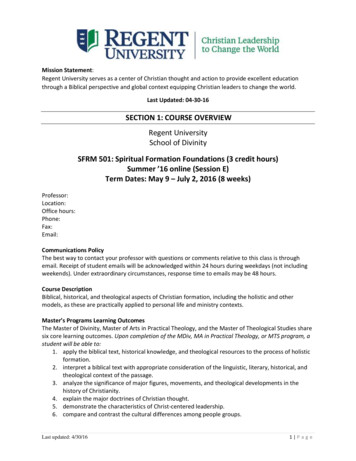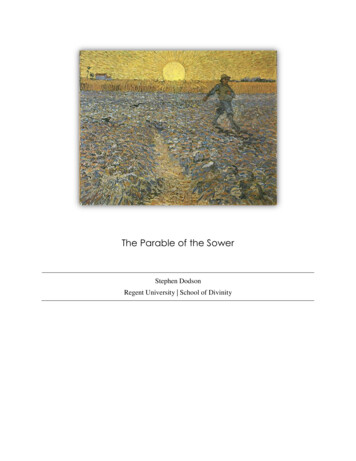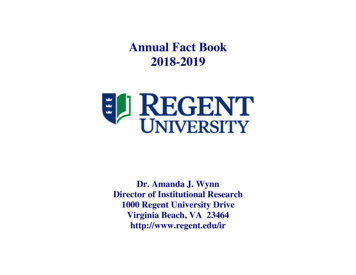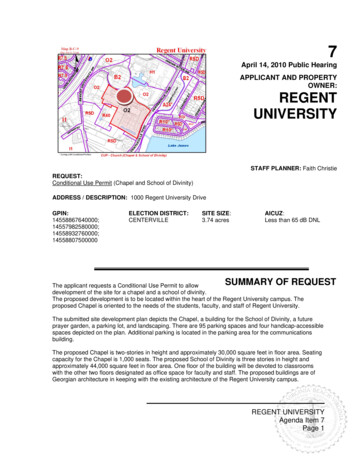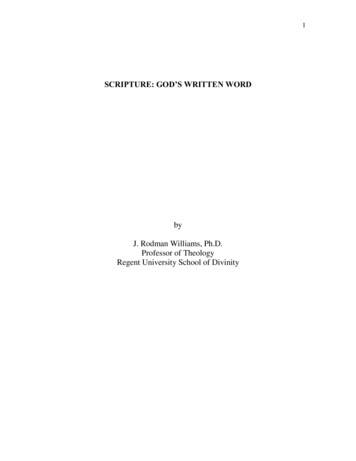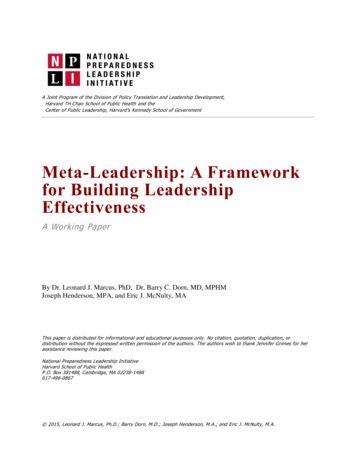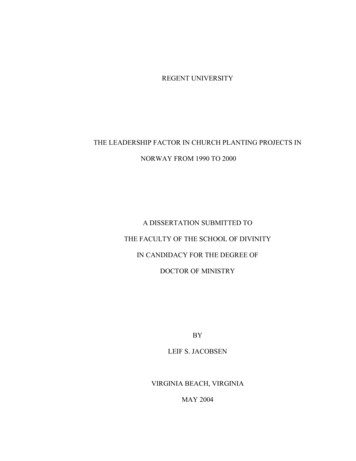
Transcription
REGENT UNIVERSITYTHE LEADERSHIP FACTOR IN CHURCH PLANTING PROJECTS INNORWAY FROM 1990 TO 2000A DISSERTATION SUBMITTED TOTHE FACULTY OF THE SCHOOL OF DIVINITYIN CANDIDACY FOR THE DEGREE OFDOCTOR OF MINISTRYBYLEIF S. JACOBSENVIRGINIA BEACH, VIRGINIAMAY 2004
2004 by Leif S. JacobsenNo original material may be used without written permission of the authorAll Rights Reserved
Dissertation CommitteeWillie L. Tjiong, D.Min.ChairDateJoseph L. Umidi, D.Min.Committee MemberDateReidar Paulsen, D.Min.Field MentorDate
ABSTRACTThis ministry project was to investigate the leadership factor in connection withchurch planting projects in Norway in order to decide how the leadership factorinfluences the level of success for the new church. The researcher conducted a surveyamong churches in Norway outside the State Church being planted from 1990 – 2000.A successful church was defined as a church that carries out the Great Commissionthrough reaching the lost with the gospel and discipling the new converts. In order tomeasure the leadership factor, the survey focused on three questions: Are the leaders well– trained? Is the leadership well structured? Is the leadership well functioning?The sample group in the data gathering process consisted of 45 churches from awide variety of denominations. The total number of churches in the target group was 132.Each church responded on a pre-defined questionnaire covering the three areas ofinterest: training, structure and function. The survey results were analyzed with acomputer based statistical tool.The survey also tried to document the connection between the leaders’ personalitytype and the level of success as a church planter. In doing this, the survey applied theMyers & Briggs Personality Type Inventory.The underlying hypothesis of this dissertation was that a well trained, wellstructured and well functioning type of leadership is one of the most important singlefactors of success when planting a new church. Through the analysis of the collecteddata, this hypothesis was documented.A significant relation was found between well functioning leaders and a successfulchurch planting. Leaders who were aware of their divine calling, based their leadershipiv
on spiritual gifts, had talents and personal maturity, could solve conflicts, involvedthemselves in the work in the congregation and had a long perspective on their leadershipsaw internal and external growth in their churches.A significant relation was also found between leaders who had training in churchplanting and successful church planting. Mere education dos not create church planters.On the contrary, some types of higher education hinder the effectiveness as churchplanter. However, specialized training together with practical training has a positiveinfluence on a leader’s effectiveness as a church planter.Lastly, it was documented that the personality type of the leaders influences theirsuccess as church planters.v
ACKNOWLEDGEMENTSWhen planning this ministry project and performing the survey, several individualshave contributed with valuable ideas, insights and material. Ommund Rolfsen, chairmanof DAWN, Norway kindly gave the author access to their material that contained a list ofnewly planted churches during the period of interest. He also gave valuable assistancewhen forming the survey that was constructed for this project.Pastor Reidar Paulsen in the church Kristkirken in Bergen has given importantinput and advice during the design and survey phases of this project. When some yearsago I was planning my post – graduate studies, Pastor Paulsen acted as a guide. As amember of the dissertation committee for this project, he completes a mentoring role forthe author and confirms a friendship that has lasted for more than twenty years.When planning and performing the survey, I received assistance from ProfessorJan Inge Jensen at the Agder University College. Without his patient help the statisticaland analytical parts of the survey could not have been written.Lastly, I want to thank the chair of the dissertation committee Professor WillieTjiong and committee member Professor Joseph Umidi for invaluable help and kindencouragements during the initial seminar phase of the Doctor of Ministry program aswell as during the ministry project.vi
CONTENTSPageABSTRACT . IVACKNOWLEDGEMENTS. VIFIGURES.XTABLES . XICHAPTER 1 - INTRODUCTION.14Statement of the Problem .17Rationale for Doing the Ministry Project .17Limitations on the Scope of the Study.18Biblical and Theological Foundations.20Description of Proposed Ministry Project .23Method of Analyzing the Problem .24Expected Results and Contributions.28Method of Evaluating the Project.28CHAPTER 2 - SURVEY OF THE LITERATURE .29Introduction .29Leadership and Leadership Teams .29Church Planting .33Personality Types .36vii
CHAPTER 3 - LEADERSHIP IN CHURCH PLANTING, THEOLOGICAL ANDTHEORETICAL CONSIDERATIONS.44Introduction .44The Objectives of the Church.44The Commission.45The church in Antioch .46The church in Ephesus.47The Church Planter.49The Church Planter and His Network .50Factors Influencing a Church Planting Project.51New Testament Perspectives .58Hermeneutical Considerations - Use of the Text.59The Leadership Factor – A Description of the Hypothesis .67CHAPTER 4 - LEADERSHIP IN CHURCH PLANTING, THE PROJECT.74Introduction .74Theory, Hypothesis and model – H1 .74Definitions and Operationalizations – H1 .81Personality Type and Christian Leadership.83Hypothesis H2 .84Data Collection and Response Rate.85Outliers .89Normality and Transformations .89Multicollinearity .90viii
Characteristics of the Churches .90Characteristic of the Church Planters .100On the testing of Hypothesis .101Tests of the Hypotheses H1 .102Tests of the Hypotheses H2 .124CHAPTER 5 - RESULTS, IMPLICATIONS, CONTRIBUTIONS AND FUTUREWORK.131Results and Implications.131Contributions .135Future Directions .136WORKS CITED .138APPENDIX A - QUESTIONNAIRE #1 .140APPENDIX B - QUESTIONNAIRE #2 .151APPENDIX C – SURVEY CANDIDATES .161APPENDIX D – SAMPLE GROUP .164ix
FIGURESFigurePage1. The MBTI Type Table. 422. The Model – Hypotheses H1 . 753. The attributes of the church planter . 784. External Resources . 795. Internal growth. 806. Geographic distribution of churches by counties . 887. Participating Churches and Year of Planting. 898. Leadership Training and Church Planting. 1039. Leadership Structure and Church Planting . 10810. Leadership Function and Church Planting . 11411. Leadership Training, Structure and Function and Church Planting . 11812. External Resources and Church Planting . 11913. Internal Growth and External Growth . 12314. MBTI profile for all participating church planters . 124x
TABLESTablePage1. Variables and definitions . 762. Variables, definitions and operationalizations. 823. Churches in the sample group. 864. Age distribution (Q1, question 8) . 915. Gender distribution (Q1, question 9) . 916. Geographic distribution (Q1, question 10) . 927. Ethnic groups (Q1, question 11). 928. Homogenous unit (Q1, question 12). 929. Average Income (Q1, question 13). 9310. Average Education (Q1, question 14) . 9411. Several leaders from one family (Q1, question 15) . 9412. Initiative from denomination or network (Q1, question 17 and question 39) . 9413. Assistance from denomination or network (Q1, question 18). 9514. Divine initiative behind church planting (Q1, question 19) . 9515. Churches with assimilation program (Q1, question 20) . 9616. Exclusive social structures (Q1, question 26). 9617. New churches as church planters (Q1, question 29). 9618. Church planting projects (Q1, question 30). 9719. Average annual growth in the new churches. 9720. Training of new church planters (Q1, question 31). 9721. Systematic evangelistic outreach (Q1, question 32). 98xi
22. Training program for evangelization (Q1, question 33). 9823. Missions involvement (Q1, question 34). 9824. External relations (Q1, question 39). 9925. Church government (Q1, question 38) . 9926. Educational level of church planters (Q1, question 35) . 10027. Church planting specific training and/or education (Q1, question 36). 10028. Mentoring follow-up on behalf of the leaders (Q1, question 37) . 10129. Kind of mentoring follow-up experienced (Q1, question 37) . 10130. College education . 10431. University or Theological Seminary Education . 10432. Church Planting seminar or similar training. 10533. Practical training in church planting. 10534. Earlier experience in church planting . 10635. Connection between education and church planting training/experience . 10636. Structure – The Congregational Meeting the supreme authority. 10937. Structure – A board elected by the congregation. 10938. Structure – A board of elders elected by the church. 11039. Structure –Pastor is the actual deciding authority . 11040. Structure – Church led by the pastor/apostle with a team of ministers . 11141. Structure – The vision bearer can be identified. . 11142. Democratic church government and outreach . 11243. Network churches and growth . 11244 The effect of leadership function on Internal Growth . 115xii
45. The effect of leadership function on Outreach . 11546. The effect of leadership function on Numerical Growth. 11647. External resources – Human support. 12048. External resources – Mentoring Follow Up, Infrequent meetings . 12149. External resources – Available Mentoring . 12150. External resources – Other Mentoring. 12251. Internal growth and outreach . 12352. Temperament types among church planters . 12553. MBTI Profiles: Leaders in Churches with Less than 100 Members . 12754. MBTI Profiles: Leaders in Churches with 100-250 Members . 12855. MBTI Profiles: Leaders in Churches Over 250 Members. 12856. MBTI Profiles: External Church Affiliation. 12957. Temperament types and growth categories . 129xiii
CHAPTER 1INTRODUCTIONFor centuries Norway has been a cultural and religious homogeneous country.After the Reformation the ties between State and Church were strengthened. During thisperiod Norway was in union with Denmark and the Norwegian and Danish kingsconfessed the Lutheran faith. As monarchs in countries with State Churches, the kingsalso were the formal head of the churches.In 1814 the Norwegian Constitution stated that the Evangelical Lutheran faithwould be the faith of the country. Any religious activity outside the state church wasstrictly regulated. The law that forbade groups of people gathered for Bible readingwithout the presence of a Vicar was not removed until 1849.Descriptive for this Lutheran dominance in religious life in Norway was the factthat the law regulating churches outside of the State Church was called the “DissenterLaw” – signifying that all non-Lutheran churches were “outside of the center”. This lawwas replaced in 1968 by a law guaranteeing the churches outside of the State Churchcertain rights and privileges. Despite of the fact that more than 90% of the populationbelong to the State Church, Norway now has a wide variety of Christian churches andcongregations displaying an exciting mosaic.The great majority of churches and denominations in Norway - outside of theLutheran State Church – that were founded between 1850 and 1906 were the result of14
15revivals and awakenings inspired by an Anglo-American influence. In the yearsfollowing this first wave, several local branches were founded when these Protestantdenominations and movements spread to different parts of the country. As with theirparent churches most congregations were planted as a result of local revivals. This wasthe case between World War I and World War II and in the 1950’s and 1960’s.When the Charismatic Movement came to Norway in the beginning of 1970, it didnot lead to the planting of churches. Rather, the ideal was that the renewed Christiansshould remain loyal to their denominations. The established denominations had a“monopoly” to plant new churches, and the new congregations that were born, remainedwithin their denomination family. From the beginning of 1980 a remarkable, plannedactivity of new church plantings started inside the mainline denominations and on anindependent basis. Two main factors led to this church planting activity.In the first half of 1980 many Norwegian pastors visited Fuller TheologicalSeminary’s School of World Mission in Pasadena, California to participate in churchgrowth seminars presented by Peter Wagner and John Wimber. Many of these pastors –belonging to b
regent university the leadership factor in church planting projects in norway from 1990 to 2000 a dissertation submitted to the faculty of the school of divinity in candidacy for the degree of doctor of minis


